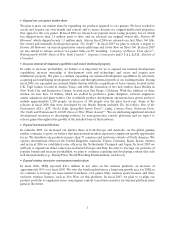THQ 2006 Annual Report Download - page 21
Download and view the complete annual report
Please find page 21 of the 2006 THQ annual report below. You can navigate through the pages in the report by either clicking on the pages listed below, or by using the keyword search tool below to find specific information within the annual report.
13
industry, the manufacturers may have better bargaining positions with respect to retail pricing, shelf space
and retailer accommodations than do any of their licensees, including us. Some of our competitors have
greater name recognition among consumers and licensors of properties, a broader product line, or greater
financial, marketing and other resources than we do. Accordingly, these competitors may be able to market
their products more effectively or make larger offers or guarantees in connection with the acquisition of
licensed properties.
As competition for popular properties increases, our cost of acquiring licenses for such properties may
increase, resulting in reduced margins. In addition, as competition for retail shelf space becomes more
intense, we may need to increase our marketing expenditures to maintain sales of our titles. Prolonged
price competition, increased licensing costs or reduced profit margins would have a negative effect on our
business and financial results.
Competition with emerging forms of home-based entertainment may reduce sales of our products.
We also compete with other forms of entertainment and leisure activities. For example, we believe the
overall growth in the use of the internet and online services by consumers may pose a competitive threat if
customers and potential customers spend less of their available time using interactive entertainment
software and more using the internet and online services.
Competition for qualified personnel is intense in the interactive software entertainment industry and
failure to hire and retain qualified personnel could seriously harm our business.
We rely to a substantial extent on the management, marketing, sales, technical and software development
skills of a limited number of employees to formulate and implement our business plan. Our success
depends to a significant extent upon our ability to attract and retain key personnel. Competition for
employees can be intense and the process of locating key personnel with the right combination of skills is
often lengthy. The loss of services of key personnel could have a material adverse effect on us.
Consolidation in the interactive software entertainment industry presents challenges with respect to
resources and integration of acquired businesses.
Consistent with our strategy to expand our internal development capabilities and distribution channels, we
intend to continue to pursue acquisitions of companies, intellectual property rights and other assets that
can be acquired on acceptable terms and which we believe can be operated or exploited profitably. As our
industry continues to consolidate, we face significant competition in making acquisitions, which may
constrain our ability to complete suitable transactions.
Further, as we acquire companies, we are faced with additional challenges. The integration of newly
acquired companies’ operations with our existing operationstakes management time and effort.
Additionally, there is a risk of loss of key employees, customers and vendors of the recently-acquired
companies. Also, if we issue equity securities to pay for an acquisition, the ownership percentage of our
existing stockholders would be reduced and the value of the shares held by our existing stockholders could
be diluted. If we use cash to pay for an acquisition, the payment could significantly reduce the cash that
would be available to fund our operations or to use for other purposes. Acquisition financing may not be
available on favorable terms or at all. We may also be required to amortize significant amounts of
identifiable intangible assets in connection with future acquisitions, which could adversely affect our
reported earnings. Future acquisitions may also require us to assume contingent liabilities that could have
a negative effect on our future results of operations.
























